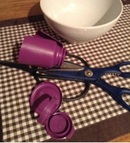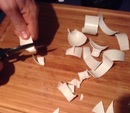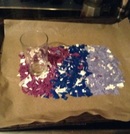Do It Yourself: How and Why We Should Recycle Our Own Plastic
13.03.2017
by Lori Schiesl
Supervisor: Ursula Münster
The Pacific Garbage Patch: an area the size, if not, twice the size of the state of Texas that is often viewed as both reality and a myth. Scientists believe that the patch itself is made up almost entirely of discarded plastic materials that have made their way into the ocean, and have been strung together by a series of mid-ocean currents. Literary scholar Molly Wallace argued that, ―nearly every cup of water from the ocean is likely to contain some plastic in some form of degradation.‖1 As quoted by Journalism scholar, Tom Morton, if a geologist of the Anthropocene were to dig into the earth, a layer of Bakelite2 could be found amongst other non-biodegradable such as: ―1784, soot, and ―1945, Hiroshima, Nagasaki, plutonium.‖3  Despite its durability and economical production cost, plastic‘s lifespan of hundreds of years has caused it to become one of the leading human-made environmental problems worldwide that negatively affects hundreds of species and ecosystems. Although many plastics can be recycled or converted into energy—a process that uses twice the amount of energy as recycling plastic—, a lot of plastic is not due to inefficient funding and/or equipment. Instead, these plastic objects are left to wander the earth for decades, hundreds, and even thousands of years. The United States alone, generates 10.5 million tons of disposable plastic each year, and recycles only approximately two percent of it.4
Despite its durability and economical production cost, plastic‘s lifespan of hundreds of years has caused it to become one of the leading human-made environmental problems worldwide that negatively affects hundreds of species and ecosystems. Although many plastics can be recycled or converted into energy—a process that uses twice the amount of energy as recycling plastic—, a lot of plastic is not due to inefficient funding and/or equipment. Instead, these plastic objects are left to wander the earth for decades, hundreds, and even thousands of years. The United States alone, generates 10.5 million tons of disposable plastic each year, and recycles only approximately two percent of it.4
Instead of relying on someone else to make sure plastic is actually recycled, I argue that we can all participate in recycling plastic ourselves. Purchasing less plastic is also one solution, however in situations where buying plastic is unavoidable, everyone who has the right tools can utilize this event to make something completely new. The purpose of this project is to offer a Do It Yourself (DIY) solution to safely recycle plastic using High Density Polyethylene (HDPE). It will discuss the history of plastic and its relationship to materialism in order to answer the question: why does plastic exist despite its environmental impact?, Talk about the different types of plastics that are used commercially, what purpose they serve, and how they can be recycled, and finally, it will introduce the DYI technique used in the adjoining ―How to Guide that offers a solution for anyone that wants to save money, be creative, and recycle their own plastic.
The Safe and Helpful Guide to Recycling Your Own HDPE Plastic #2
Interested in creating your own plastic objects, but don’t know how? Follow the steps below to successfully melt and re-mold your own plastic using HDPE plastic #2. The object molded in this example will be a cutting board, but you can make whatever you want.
Warning: Do not use plastic objects for this project that have originally contained harmful chemicals in order to make items intended for consumption (food, drinks, ect.).
 The first and most important step is to collect and wash a few plastic bottles. This picture shows the bottles— stripped of their labels, and washed thoroughly to ensure all contents have been removed— that were used to make a 100% recycled plastic cutting board.
The first and most important step is to collect and wash a few plastic bottles. This picture shows the bottles— stripped of their labels, and washed thoroughly to ensure all contents have been removed— that were used to make a 100% recycled plastic cutting board.
 After the bottles have dried, inspect the bottles for any adhesive leftover from the labels. A simple solution of vinegar along with a sharp utensil can rid the bottles of this residue. Then proceed to cut the bottles into small pieces as shown in the photos. Pay attention to the different pieces of the bottle. Often times the plastic cap is a different type of plastic than the bottle. An SPI code should visible on each individual piece.
After the bottles have dried, inspect the bottles for any adhesive leftover from the labels. A simple solution of vinegar along with a sharp utensil can rid the bottles of this residue. Then proceed to cut the bottles into small pieces as shown in the photos. Pay attention to the different pieces of the bottle. Often times the plastic cap is a different type of plastic than the bottle. An SPI code should visible on each individual piece.
 Once enough bottles have been cut, set you oven to 180oC. Since HDPE poorly absorbs smells, stronger smelling contents will release robust odors during the baking process. For this reason, make sure your oven is in a well-ventilated room. Arrange the plastic shards in whatever fashion you would like on a pan lined with baking paper. You can also reduce the size of your plastic even more by placing the shards in a food processor and grinding it down into a dry pulp. In this example, a food processor was not available, and the shards were arranged by color using a small glass as a model for a hole.
Once enough bottles have been cut, set you oven to 180oC. Since HDPE poorly absorbs smells, stronger smelling contents will release robust odors during the baking process. For this reason, make sure your oven is in a well-ventilated room. Arrange the plastic shards in whatever fashion you would like on a pan lined with baking paper. You can also reduce the size of your plastic even more by placing the shards in a food processor and grinding it down into a dry pulp. In this example, a food processor was not available, and the shards were arranged by color using a small glass as a model for a hole.
 When satisfied, place plastic in the oven for about 10-15 minutes, or when the plastic is gooey. Remove the plastic from the oven, make any necessary adjustments using heat resistant gloves, and let it cool. For this example, the plastic was cooled, flipped over, and placed back into the oven for molding purposes.
When satisfied, place plastic in the oven for about 10-15 minutes, or when the plastic is gooey. Remove the plastic from the oven, make any necessary adjustments using heat resistant gloves, and let it cool. For this example, the plastic was cooled, flipped over, and placed back into the oven for molding purposes.
 Congratulations! You have now learned how simple it can be to recycle your own plastic by using empty bottles that were originally destined to be thrown away.
Congratulations! You have now learned how simple it can be to recycle your own plastic by using empty bottles that were originally destined to be thrown away.
1 Molly Wallace, Risk Criticism: Precautionary Reading in an Age of Environmental Uncertainty (University of Michigan Press: Michigan, 2016) 127-128.
2 Bakalite was the first synthetic polymer made entirely of molecules not found in nature in 1907.
3 Wallace, Risk Criticism, 127.
4 Plastic Garbage,‖ Eco360, http://www.sustainablecommunication.org/eco360/what-is-eco360s-causes/plastic-garbage [accessed Jan. 5, 2017].

